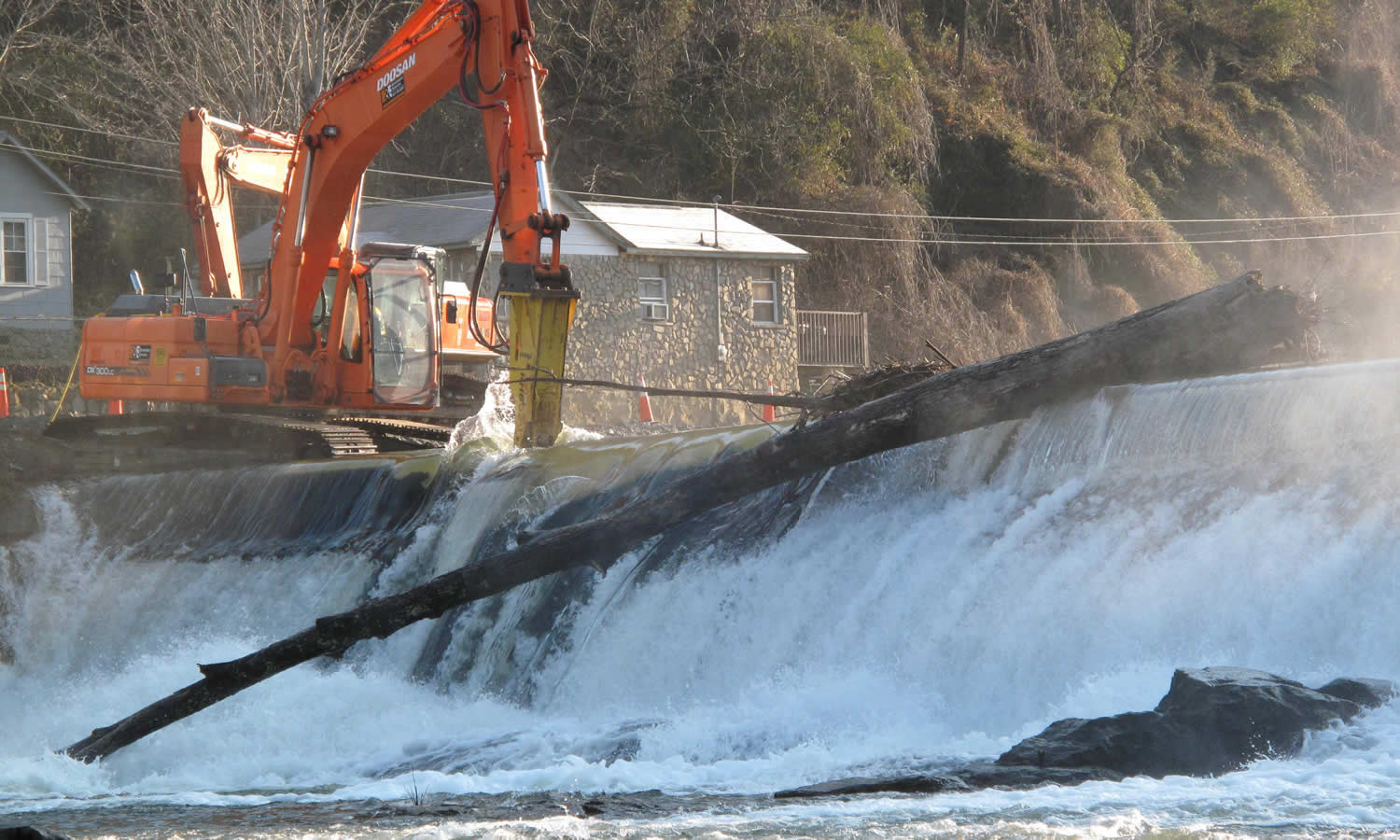
Two years after watching a hydraulic hammer begin removing the Dillsboro Dam from the Tuckasegee River (pictured above), U.S. Fish & Wildlife Service biologist Mark Cantrell is excited about what the removal is coming to mean for life beneath the river’s surface.
“When the Nantahala area relicensing process offered the possibility of dam removal, we saw an opportunity to transform a portion of the river and restore part of our lost natural heritage,” said Cantrell, who specializes on the impacts of dams on rivers. “What we’re seeing now is the rebirth of that section of river and a confirmation of the decision to remove it. There’s no question about it — if you are an angler, boater, fish or bug, the Tuckasegee River is better with the Dillsboro Dam removed.”
One of a dam’s great impacts on a river is changing the area behind it from a free-flowing river to a reservoir, typically unsuitable habitat for most native stream species. By removing Dillsboro Dam, nearly one mile of pooled water returned to flowing river. Twice a year in 2008, 2010 and 2011, biologists monitored fish and other aquatic life, providing a before and after picture of how removal affected the river, especially at the site of the former reservoir.
A species considered foremost during dam removal discussions was the Appalachian elktoe, a federally endangered mussel found only in Western North Carolina and a sliver of East Tennessee. The elktoe did not exist in the reservoir pool, but post-removal monitoring found more than 140 elktoe mussels in the former reservoir area, a sign the previously bisected population will reconnect, strengthening its long-term viability.
Before removal, the reservoir area was home to a diminished variety of macroinvertebrates. These insects, crayfish, and other animals without backbones form much of the life in a stream ecosystem. Just more than a year after the removal, macroinvertebrate diversity had increased, on par with sites upstream and downstream of the reservoir site. Among macroinvertebrates, biologists often pay special attention to mayflies, caddisflies, and stoneflies, which tend to be sensitive to water quality and are indicators of stream health. Following removal, the diversity of these three insect groups increased dramatically in the former reservoir area — from a monitoring low of two types in October 2008 to a high of 40 in May 2011. Using macroinvertebrate numbers and diversity as a measure of stream health, their return lifted this stretch of river from a “poor” quality rating in 2008 to a “good” ranking in May 2011.
As expected, fish diversity has responded somewhat more slowly to the dam removal, though biologists have noted the fish community is shifting to one typical of a Western North Carolina river, and the number of fish species dependent on flowing water is increasing. Additionally, in May 2011, biologists found an olive darter, a species of conservation concern for state and federal biologists, upstream of the dam site for the first time. The discovery could mean the fish took advantage of the dam’s removal to expand its range into upstream habitat.
Biologists also made an encouraging discovery downstream of the dam site. For several days in 2008 and 2009, biologists scoured the river downstream of the dam searching for mussels. They uncovered 1,137 Appalachian elktoes, which were all systematically tagged and moved upstream, away from potential harm from the demolition. Despite this, one of the concerns about removing the dam was the amount of sediment held behind its concrete dam and the impact it might have on downstream life. To minimize the sediment’s impact, Duke Energy dredged nearly 58,000 cubic yards of sand from the reservoir before dam removal. The U.S. Fish & Wildlife Service also stipulated that water clarity be monitored during removal, and operations paused if the water became too cloudy. In searching the downstream area since removal, biologists have found an additional 622 elktoe mussels, many of which were likely there during removal — a testament to the care with which the dam was removed.
“Regarding the health and well-being of the Tuckasegee River, removing Dillsboro Dam has been a success,” said Hugh Barwick, the Duke Energy biologist who managed the dam removal and biological monitoring. “The removal was a positive step in improving aquatic life in the Tuckasegee River in the vicinity of the former dam and reservoir.”
The rock and concrete Dillsboro Dam was 12 feet high and 310 feet long. The Dillsboro Hydroelectric Project, which created the reservoir, was one of the smallest hydro projects operated by an investor-owned utility in the nation. Thirty organizations in the Tuckasegee Cooperative Stakeholder Team, including Duke Energy, signed an agreement in 2003 calling for removal of the dam. Duke acquired Dillsboro Hydroelectric Project when it purchased Nantahala Power and Light from Alcoa in 1988, and power generation ceased after flooding damaged the powerhouse in 2004. It was one of a series of Duke Energy hydroelectric facilities in North Carolina’s Tuckasegee River Basin. Private hydroelectric facilities on navigable waterways like this require Federal Energy Regulatory Commission licenses for operation. Federal law requires operators to address impacts to fish and wildlife, including the dam’s limitation of up- and downstream fish movement.
(photo by Gary Peeples, Asheville Field Office, USFWS)



Free the Rivers!